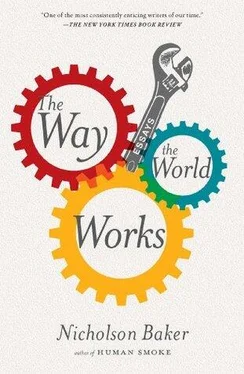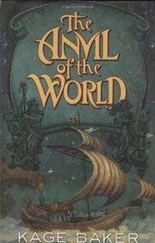Nicholson Baker - The Way the World Works
Здесь есть возможность читать онлайн «Nicholson Baker - The Way the World Works» весь текст электронной книги совершенно бесплатно (целиком полную версию без сокращений). В некоторых случаях можно слушать аудио, скачать через торрент в формате fb2 и присутствует краткое содержание. Год выпуска: 2012, Издательство: Simon & Schuster, Жанр: Публицистика, Критика, на английском языке. Описание произведения, (предисловие) а так же отзывы посетителей доступны на портале библиотеки ЛибКат.
- Название:The Way the World Works
- Автор:
- Издательство:Simon & Schuster
- Жанр:
- Год:2012
- ISBN:нет данных
- Рейтинг книги:4 / 5. Голосов: 1
-
Избранное:Добавить в избранное
- Отзывы:
-
Ваша оценка:
- 80
- 1
- 2
- 3
- 4
- 5
The Way the World Works: краткое содержание, описание и аннотация
Предлагаем к чтению аннотацию, описание, краткое содержание или предисловие (зависит от того, что написал сам автор книги «The Way the World Works»). Если вы не нашли необходимую информацию о книге — напишите в комментариях, мы постараемся отыскать её.
), here assembles his best short pieces from the last fifteen years.
The Way the World Works
OED
Modern Warfare 2
Through all these pieces, many written for
, and
, Baker shines the light of an inexpugnable curiosity.
is a keen-minded, generous-spirited compendium by a modern American master.
The Way the World Works — читать онлайн бесплатно полную книгу (весь текст) целиком
Ниже представлен текст книги, разбитый по страницам. Система сохранения места последней прочитанной страницы, позволяет с удобством читать онлайн бесплатно книгу «The Way the World Works», без необходимости каждый раз заново искать на чём Вы остановились. Поставьте закладку, и сможете в любой момент перейти на страницу, на которой закончили чтение.
Интервал:
Закладка:
Things were quieter once we entered the San Trovaso canal and slid past a boatyard, or squero , where there are often three or four gondolas turned on their sides like dozing dugongs, having their hulls sanded down and repainted. Then we turned right on All-Saint’s Canal, and right again on the Canal of Lawyers, and Grossi pointed out the center of gondola history — the shop of the Brothers Tramontin. Domenico (El Grando) Tramontin perfected the modern gondola’s asymmetries in the 1880s, and Grossi was of the opinion that the Brothers Tramontin continue to make the best and longest-lived gondolas. But they cost ten million lire more than anyone else’s, Grossi said. His own boat is the work of “Nino” Giuponi, another squerarolo of legend, now retired. Giuponi was more of an experimenter than the later Tramontins; he introduced the use of plywood in some of his boats, which some disparage, although it can help the hull keep its shape in the presence of constant motorwaves.
Finally we reached the Bridge of Fists. The bookstore was gone. Its old shelves were holding lettuces and radishes, overflow from the highly successful produce barge that moors there. But it didn’t matter. We bought some spinach and went home — altogether a delightful trip.
Then, in my son’s sleepy company, I took a ride with a pilot named Marco, who worked at the gondola station at the Church of the Salute and looked like Billy Crystal. When I asked Marco what the most difficult thing was about being a gondolier, he thought for a moment. “The other gondoliers,” he said. “Mostly the old gondoliers. They have small brains, believe me.” As we passed the Church of San Trovaso, where there is an altar for boatbuilders with a gondola carved into it, Marco got a call on his portable phone. He set up a rendezvous while ducking under a bridge. We went by Tramontin’s boatyard, deserted now except for a small brown dog sniffing some new sawdust. We got onto the subject of boat maintenance. It’s important, Marco said, to wash your boat for half an hour every day. “It’s what my father teach to me, when I was young. Every day. With new water, not salt water. New water the gondola, then you dry the gondola.”
“Some gondoliers seem very good—” I began to say.
Marco misheard the word “seem” and cut in. “Believe me, sir,” Marco said with a self-deprecating laugh, “but I have a horrible voice. Better not to sing, just enjoy the nice weather.” In his father’s time, twenty or thirty years ago, a family would hire a gondola for the whole day, he said. I asked how much it would cost to do that now. “I think eight hundred thousand lire.”
That’s a pretty steep day rate, but (I said to myself) one total-immersion gondolar day — with a micro-cruise budget of 450 dollars — would give a visitor new to Venice a comprehensive oar’s-eye notion of the several neighborhoods and many churches. And each bought ride would have a political component: it would be an act of defiance against the water taxis and other arriviste wave-generators, a vote for a quieter city, something more than mere tourism. Why not skip the twelfth or fifteenth absurdly expensive meal in which three kinds of pale shellfish are mingled with a noodle of little distinction and instead buy eight dollars’ worth of cheese and olives and whatnot at the local salumeria and eat out at twilight in the very kind of boat that kings and popes and moody poets would have ridden in?
Next door to the Tramontin brothers’ squero is a gondola shop run by Daniele Bonaldo. A twenty-four-year-old American anthropology student named Thomas Price recently built a life-size gondola there with the help of a Watson Fellowship. Bonaldo is childless and says he’s tired of building boats, so he agreed to teach the art to Price. On the tenth of May I went to a party at Bonaldo’s place to celebrate “The Launching of the First American Gondola.” Price’s boat looked authentic — black, with a dark-red hull and a small, tasteful, delicately rendered American flag, breeze-ruffled, carved into one of the decorative elements by an itinerant artisan. Price has built sailboats and rowboats in Maine, but he was attracted to the gondola, he told me, because there are many unusual things about it. Not only is it asymmetrical and rowed in a standing position — but also its components are bent into shape by brushing them with water over a fire of marsh reeds (a blowtorch will also work and is handier in the winter), and they are assembled without paper plans, by cutting the pieces in accordance with a wooden template, the cantier. The prosecco that Price poured on the prow to christen the boat mixed with the sun-warmed and not-completely-cured black lacquer to produce an inspiring Saturday-morning smell. Price told me that he would like his gondola to be rowed on the canals of Venice, but it may be that a couple of entrepreneurs in Maine buy it for a novelty riverboat service there: it’s Bonaldo’s boat to sell.
Before I left the party I talked to Price’s sister, Anne. She was living in Mestre, making a living playing North Carolina fiddle music on the steps of Venetian churches, which is forbidden without a busker’s license. I asked her if she had ever ridden in a gondola. One time she was walking across a bridge, she said, and a young, handsome gondolier with long blond hair offered her a free ride. She said okay. They went down a sludgy canal by a conservatory, where she could hear pianos and clarinets, and then out onto the Grand Canal. The whole time the gondolier was saying how sorry he was that she had no one to be kissing while she was riding the gondola. I asked her if the two of them had hit it off. “We hit it off,” she said, “but I maintained my distance. I see him from time to time. It’s like a musical skill to be able to row a gondola. When I see gondoliers just standing all day on bridges, saying Gondola, gondola, waiting, it’s like they’re begging. It’s so similar to me when I play violin on the street, waiting for somebody to stop and listen.” Her gondolier’s name was Eros.
Eros the Oarboy is as familiar today as he was in Lady Chatterley’s Lover, where Giovanni the gondolier is “devoted to his ladies, as he had been devoted to cargoes of ladies in the past.” At night there is, I have noticed, a considerable amount of giggly public gondolier-kissing in the city by groups of foreign women carrying bottles of wine. My wife made up a song: Come into my gondola, I’m going to fondle ya. Once, in the middle of the Grand Canal at ten o’clock in the evening, we passed a gondola that was sitting motionless on the water with two women and two stripe-shirted men in close converse within; one of the men greeted our rower and called out (my wife translated for me), “How do you say ‘double bed’ in Spanish?”
All this is as it should be. My minor complaint is just that there is no privacy available to the passengers of these boats — privacy not to go hog wild, necessarily, but simply to talk without constraint. You are compelled to take the waters in a convertible. The felze (wooden winter cabin) and tendalin (canvas summer hood) were renounced forty or fifty years ago — too time-consuming to set up, and unnecessary, it was thought, for the demands of tourism. Unless these traditional enclosures are revived, the conventional tender moment on the water will be forever inhibited by the steady oar-plying and tour-guiding going on abaft. You tentatively take the spousal hand, and then hear, from behind, “This is Goethe house. Goethe lived in this house.” All potential romance has been realigned in favor of the presiding gondolier himself. Male passengers are adjuncts, balding lumps of flesh with wallets.
The one real love story I know between a gondolier and a straniéra is the one between Bruno Palmarin, the profusely mustached hereditary gondolier who rowed at our wedding, and Susan Nickerson, an American mosaicist. Susie grew up in Long Island, the daughter of two judges. She came to Venice in 1972 after art school to study mosaic-making. Late in December, on her birthday, she went alone to Torcello. The sacristan unlocked the church for her; she was the only person there. Then she got a boat back to Venice and went to an antique store where she knew some people. She told them it was her birthday, and they bought a bottle of spumanti to celebrate. Just then Bruno Palmarin came by — a big, polite man carrying two baby rabbits in a cage. (They were a Christmas present for his niece and nephew.) Bruno looked a little like the bust of the Emperor Constantine, Susie thought: the same large, spiritual eyes. Later she found out he was a gondolier.
Читать дальшеИнтервал:
Закладка:
Похожие книги на «The Way the World Works»
Представляем Вашему вниманию похожие книги на «The Way the World Works» списком для выбора. Мы отобрали схожую по названию и смыслу литературу в надежде предоставить читателям больше вариантов отыскать новые, интересные, ещё непрочитанные произведения.
Обсуждение, отзывы о книге «The Way the World Works» и просто собственные мнения читателей. Оставьте ваши комментарии, напишите, что Вы думаете о произведении, его смысле или главных героях. Укажите что конкретно понравилось, а что нет, и почему Вы так считаете.












